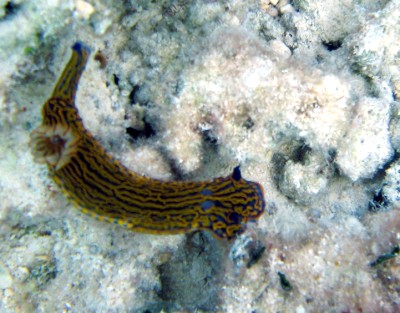Hypselodoris zebra - old reference and new photo
February 18, 2010
From: Thaddeus Murdoch

Took a photo of a Hypselodoris zebra in Castle Harbour, Bermuda in January on a fringing reef in 2m depth. My research assistant was doing fish surveys concurrently and observed over 20 specimens within a 200-m by 10-m area. This highly clustered distribution perhaps confirms it's lecithotrophic life history strategy, as discussed in earlier posts for the species on your fine forum.
Below is a key reference for the species regarding it's endemic status in Bermuda which may be of use to your readers.
Locality: Castle Harbour, 2m, Bermuda, Atlantic Ocean, 28 January 2010, Fringing Reef within enclosed harbour. Length: 10 cm. Photographer: Thaddeus Murdoch.
- Thompson, T.E. (1977). The taxonomic status of two Bermudan Opisthobranchs. Journal of Molluscan Studies, 43: 218-222.
Thaddeus Murdoch
tjmurdoch@gov.bm
Murdoch T.J.T., 2010 (Feb 18) Hypselodoris zebra - old reference and new photo. [Message in] Sea Slug Forum. Australian Museum, Sydney. Available from http://www.seaslugforum.net/find/23230
Dear Thad,
Thanks for the photo. From other photos I have seen, it looks as though this species loses the white band around the edge of the mantle at it grows larger. Your colour form has many similarities to the west Atlantic form of H. picta.
I referred to Tom Thompson's paper in an earlier message [#622]. We can only hope that someone will consider the reproductive biology of the west Atlantic chromodorids to be worthy of study sometimes soon. Although some direct developers and lecithotrophic developers have restricted geographical distributions there are always examples which break the rules. As far as the local clustering you describe, I suspect this is in response to the presence of their preferred food sponge(s). Since veliger larvae settle and metamorphose on their food sponges, and the eggs of direct developers are usually laid on or near their food sponges, this sems to be the most likely cause of clustering, which is found in species of all development types.
Which brings me to the close-up I have included alongside. I am intersted in accumulating more data on the feeding specificity of the chromodorids so I always look carefully at photos for signs of potential food sponges. Most species of Hypselodoris feed on dysideid sponges. I am not sure if their is a ravaged dysideid colony in your photo or not. If you can see more in the original photo or have another photo which shows signs of such a sponge I would very much like a higher resolution scan to add to the Forum as a possibe feeding record.
Best wishes,
Bill Rudman
Related messages
-
Photos of Hypselodoris zebra & eggs
From: Daniel Geiger, March 12, 1999 -
Re: Hypselodoris zebra larvae
From: Bill Rudman, February 26, 1999 -
Re: Hypselodoris zebra larvae from Bermuda
From: J.E. Austin, February 20, 1999 -
Hypselodoris zebra larvae from Bermuda
From: J.E. Austin, February 18, 1999 -
re: Sea Slug Forum
From: J.E.Austin, November 11, 1998 -
Re: J.E.Austin's Hypselodoris zebra query
From: Bill Rudman, November 9, 1998
